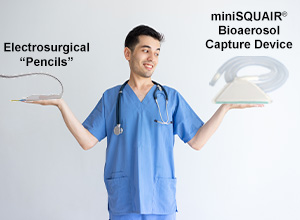
22 Sep Ineffective Compliance vs. Value-Based Outcomes
 After many years of neglect followed by limited interest, primarily by operating room personnel, bioaerosol capture (“smoke evacuation”) has now become a political issue due to the herculean efforts of AORN’s legislative arm. Congratulations to those professionals for getting the attention and support of state politicians which has resulted in mandates for smoke evacuation in certain domestic surgical facilities.
After many years of neglect followed by limited interest, primarily by operating room personnel, bioaerosol capture (“smoke evacuation”) has now become a political issue due to the herculean efforts of AORN’s legislative arm. Congratulations to those professionals for getting the attention and support of state politicians which has resulted in mandates for smoke evacuation in certain domestic surgical facilities.
Now the race is on as the medical industry tries to jockey for sales of electrosurgical “pencils” to healthcare systems; technology which is over twenty (20) years old and who’s functional effectiveness remains undocumented by third party testing. In contrast, there is one company, Nascent Surgical, LLC, who’s bioaerosol capture device named, “miniSQUAIR®,” now in its seventh year of sales, is disposable, conforms to any body contour and does not interfere with the surgeon’s vision. Best of all, it has a 98% smoke capture efficiency1 when used per its Instructions For Use and 100% capture capability for airborne transmitted bioaerosols and 60% of droplet transmitted bioaerosols.2 These data surpass the ISO 16571:2014 minimum standard for smoke (bioaerosol) evacuation of 90% as documented by the manufacturer (Section 4.3).3
The first claim, 98% smoke capture efficiency, includes nanoparticles that comprise 80% of surgical plume. Chronic inhalation of plume, in susceptible individuals, can result in serious systemic illnesses including cardiac, neurodegenerative, cancer and collagen diseases.4 Certainly, healthcare systems that fund their own workman compensation claims should be concerned by this.
The second claim pertains to consideration of bioaerosol capture as a potential infection control device. Clinical studies have shown that the miniSQUAIR® is superior to the ESU “pencil” for capturing particulates present over open surgical wounds5 and for aerosols produced by mechanical devices during nasal procedures6; possibly true of orthopedic cases? Another clinical study comparing two groups of posterior lumbosacral spinal fusion cases, with and without use of the miniSQUAIR® showed over a 30% decrease in superficial and deep post-operative wound infections when the capture device was used.7
This third party testing data should be compared with that offered by the “pencil” distributors. To date, I do not believe that such contrasting data is currently available.
As state-sponsored mandates progress across the country, healthcare personnel will be pressured to buy untested “pencils” to achieve compliance only vs. purchase of the only available alternative technology (miniSQUAIR®) which will not only satisfy compliance but will also offer staff and patients proven protection from both short and long-term ill effects of exposure to surgical bioaerosols.
The time to choose is now!
REFERENCES
- University of Minnesota, Department of Mechanical Engineering, Particle Calibration Laboratory. Bernard Olson, PhD, Manager. Dated Nov. 21, 30, 2013.
- Schultz, L. Can Efficient Smoke Evacuation Limit Aerosolization of Bacteria? AORN J. 2015; 102(4): 7-14.
- ISO 16571:2014. Systems for evacuation of plume generated by medical devices. First Ed., 2014-03-15.
- Buzea C, Pacheco II, Robbie K. Nanomaterials and nanoparticles: sources and toxicity. Biointerphases 2007; 2(4):MR 17-MR 71.
- Liu N, Filipp N, Wood KB. The Utility of Local Smoke Evacuation in Reducing Surgical Smoke Exposure in Spine Surgery. A Prospective Self-Controlled Study. The Spine J. 000 (2019): 1-8.
- Dhruv S, Ye M, Campiti V, Ting JY. Mitigation of Aerosols Generated During Rhinologic Surgery: A Pandemic-Era Cadaveric Simulation. Otolaryngol. Head Neck Surg. 2021: 164(2): 433-442.
- Kim S, Schultz L. Can Capture of Surgical Smoke Decrease Post-Operative Infection Rates (SSI)? Preliminary Report. Poster # 311. Presented at the 18th Annual ISASS meeting, April 11-13, 2018. Toronto, Canada.
